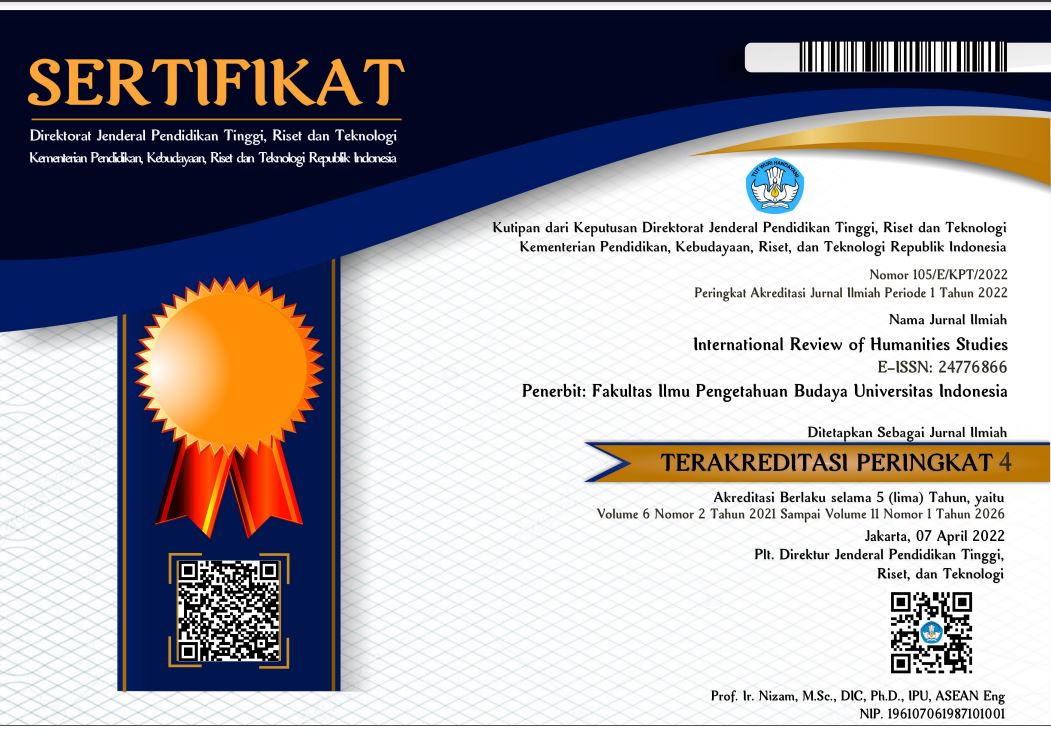International Review of Humanities Studies

Abstract
This paper examines the national narrative presented in the biographical film Soekarno: Indonesia Merdeka (2014). The analysis employs a film studies approach to explore the interplay between visual and narrative strategies within the framework of Eisenstein's theoretical perspectives. Christian Metz's semiotic theory is utilized to decode the signs embedded throughout the film. The study focuses on the visual and narrative strategies employed in the biopic to elucidate the national narrative, particularly through the portrayal of the character Soekarno and his interactions with other key figures. Visual strategies, encompassing cinematography and mise-en-scene techniques, bring to light signs that are intricately linked to national narratives. Simultaneously, the narrative strategy reinforces the coherence of this narrative through pivotal plot points in the film's storyline. In this biopic, audio is construed as an underpinning element that enhances the information and meaning already conveyed through the visuals. The holistic analysis of visual, narrative, and auditory components provides a comprehensive understanding of how the national narrative is constructed and conveyed in Soekarno: Indonesia Merdeka.
References
Anderson, B. R. O. 1. (2006). Imagined communities: reflections on the origin and spread of nationalism. Rev. ed. London; New York, Verso.
Bambang, A.K., Prihatini, N.S., Hastanto, S., & Dharsono. (2019). Analysis of Docudrama History and Referential Reconstruction of Sang Kiai Movies: Adaptation of Biographical Historiographic Texts to Biopic Film. Capture: Jurnal Seni Media Rekam, 10:2, 20-44.
Bingham, D. (2010). Whose lives are they anyway? The biopic as contemporary film genre. New Brunswick, NJ: Rutgers University Press.
Bordwell, D., Thompson, K., & Smith, J. (2016). Film art: An introduction (10th ed.). New York: McGraw-Hill.
Bruner, M. L. (2005). Rhetorical Theory and the Critique of National Identity Construction. National Identities 7:3, 309–27.
Bruzzi, S. (2000). New Documentary: A Critical Introduction. London & New York: Routledge.
Cobley, P. (2001). The Routledge companion to semiotics and linguistics. London; New York: Routledge.
Compton, B.R. (1954). BRC-23: Soekarno Speaks. Institute of Current World Affairs. 12 Not for publication.
Chudori, L.S. (2013). Seorang Soekarno untuk Indonesia. Majalah Tempo. https://majalah.tempo.co/read/film/144298/seorang-soekarno-untuk-indonesia (Downloaded on: 17 August 2020)
Chudori, L.S. (2015). Dari Gie hingga Tjokroaminoto: Sebuah diskusi tentang film biopik. Serambi Salihara, 1-8. Makalah diskusi.
Custen, G.F. (1992) Bio/Pics: How Hollywood constructed public history. New Brunswick, NJ: Rutgers University Press.
Dixon, S. (1998). Picture Perfect: Artist Stereotypes in Film. Art Papers 22:6, 32‒33.
Doherty, T (2003). Sex, Half-truths and Videotape: Auto Focus and Confessions of a Dangerous Mind. Cineaste 28:2, 10‒13.
Eisenstein, S.M. (2006). Неравнодушная Природа. Том. 2. Москва: музей кино.
Felleman, S. (2001). Dirty Pictures, Mud Lust, and Abject Desire. Film Quarterly 55:1, 27‒41.
Fischer, L. (2000). Marlene: Modernity, Mortality, and the Biopic. Biography: An Interdisciplinary Quarterly 23:1, 193‒211.
Hoberman, J. (1993). Heroes and memories. Sight & Sound 3:3, 6‒9.
Jacobs, S. (2014). Vasari in Hollywood: Artists and Biopics. Framing Pictures: Film and the Visual Arts. Edinburgh: Edinburgh University Press, 38‒64.
Kellas,James G. (1998). The Politics of Nationalism and Ethnicity. USA: St. Martin’s Press, Inc.
Letort, D. (2012). The Rosa Parks Story: The Making of a Civil Rights Icon. Black Camera: An International Film Journal 3:2, 31‒50.
Levy, L (2002). Storytelling: Great Love and Great Work in the Biopic. Radical Society: Review of Culture & Politics 29:2, 87‒101.
Maio, K. (1994). In the shadowland of the Hollywood biopic. Fantasy & Science Fiction 87:4‒5, 77‒84.
Metz, C. (2006). Film language A Semiotics of the Cinema. Chicago: The University of Chicago Press.
Oliver, C. (1993). That’s Life. [Biographical motion pictures.] Reason 24:11, 56‒57.
O’Meara, R., & Stevens, C. (2012). While His Guitar Gently Weeps: Memory, Documentary and the Music Biopic. The Soundtrack 5:2, 173‒188.
Preece, J. (2003). Between Identification and Documentation: ‘Autofiction’ and ‘Biopic’: The Lives of the RAF. German Life and Letters 56:4, 363‒376.
Rizki, D. (2017). Soekarno Komunis? Berikut Kesaksian Soeharto. https://wartakota.tribunnews.com/2017/10/03/soekarno-komunis-berikut-kesaksian-soeharto. (Downloaded on: 17 August 2020)
Rose, Rose (2015) Representasi kepemimpinan Soekarno dalam film “Soekarno: Indonesia Merdeka” ditinjau dari analisis semiotik = Semiotic analysis of Soekarno’s leadership representation in the film “Soekarno: Indonesia Merdeka”. Bachelor thesis, Universitas Pelita Harapan
Schlotterbeck, J [Keith]. (2010). The Popular Musical Biopic in the Post-Studio Era: Four Approaches to an Overlooked Film Genre. Ph.D. Thesis, University of Iowa
Spirou, P. (2011). Behind the Music: Representations of Popular Music Artists in the Contemporary Musical Biopic. Instruments of Change: Proceedings of the International Association for the Study of Popular Music Australia-New Zealand 2010 Conference. Melbourne, Vic.: International Association for the Study of Popular Music, 131‒136.
Teguh, I. (2018). Memukul Kaum Pergerakan dan Kisah Sukarno di Penjara Banceuy https://tirto.id/memukul-kaum-pergerakan-dan-kisah-sukarno-di-penjara- 13 banceuy-cT1j (Downloaded on: 17 August 2020)
Todorov, T. (1971). The 2 Principles of Narrative. Diacritics, 1:1, 37-44. Vidal, B. (2007). Feminist Historiographies and the Woman Artist’s Biopic: The Case of Artemisia. Screen 48:1, 69‒90.
Weis, E., & Belton, J. (1985). Film Sound: Theory and Practice. New York: Columbia University Press.
Recommended Citation
Gunawan, Eric and Wibawarta, Bambang
(2024)
"NARRATIVE OF NATIONALISM IN MISE-EN-SCENE OF BIOPIC SOEKARNO: INDONESIA MERDEKA,"
International Review of Humanities Studies: Vol. 9:
No.
1, Article 1.
DOI: 10.7454/irhs.v9i1.1268
Available at:
https://scholarhub.ui.ac.id/irhs/vol9/iss1/1
Included in
Anthropology Commons, Art and Design Commons, Creative Writing Commons, Cultural Heritage Law Commons, Education Law Commons, Film and Media Studies Commons, History Commons, Intellectual Property Law Commons, International and Area Studies Commons, Legal Writing and Research Commons, Linguistics Commons, Museum Studies Commons, Philosophy Commons, Urban Studies and Planning Commons


